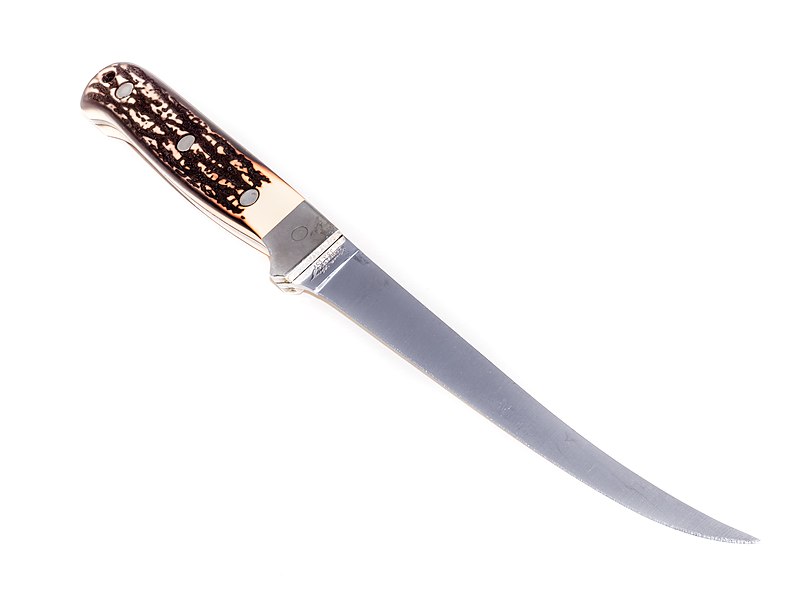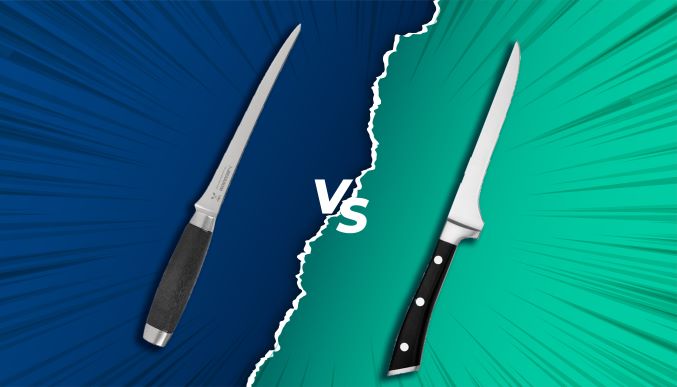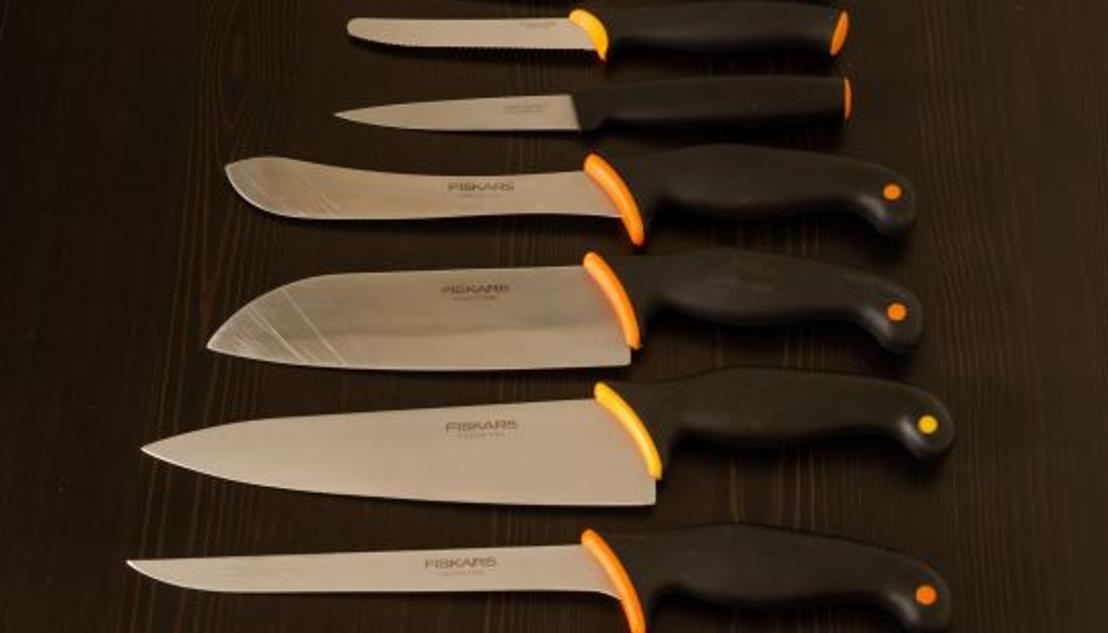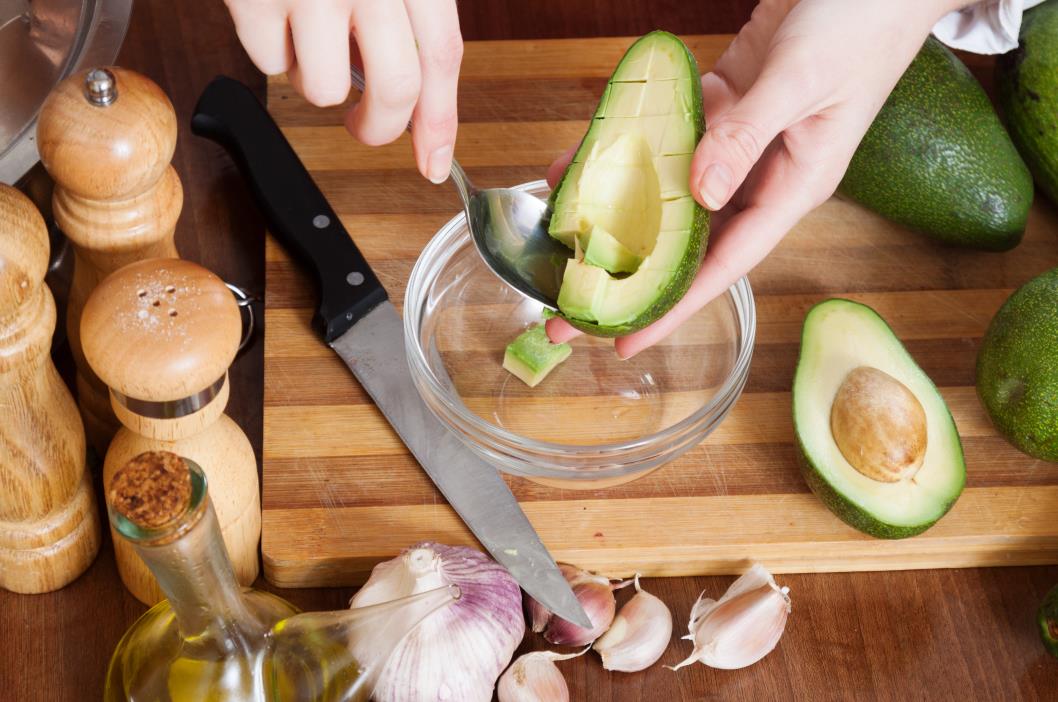Not yet a chef, huh? You shouldn’t be embarrassed. You’ll bake a lot of soufflés on your way there. But just before you receive your toque blanche (which is French for “chef hat”), Gordon Ramsey’s minions will appear in a dream and ask you a question.
“Boning knife vs. fillet knife: what’s the difference?” They are both common kitchen knives very similar in terms of design, size, and even materials. But there are a couple of features that set them apart, which make them useful in different situations.
In a nutshell, a boning knife is used for separating meat from the bone by easily cutting through sinew, muscle, fat, and connective tissue. Thus, they are a bit harder than their counterparts and are generally used for tougher meats and poultry.
Fillet knives, on the other hand, are more flexible and a bit thinner. This makes them the perfect choice for removing skin and deboning more delicate meat, like fish.
This information should be enough for you not to be called a “donkey” in your dream. But if you want to delve a little deeper, we gave these tools an exhaustive analysis below. You know, just in case you’re dead set on getting that funny chef bonnet.
Table of contents
What is a boning knife used for?
As its name obviously, and quite inappropriately suggests, a boning knife is mainly used for separating meat from the bone. It features a long, narrow, non-serrated blade, usually in the 5-7 inches range, that ends in a slight curve up to a very fine, sharp tip.
Most boning knives have a finger guard, which is a little notch where the blade meets the handle. This is a safety feature that will protect your fingers when working with slippery ingredients. Depending on the materials used, the blades should be semi-flexible, with a flat cutting edge.

These knives come with varying degrees of flexibility in order to comply with different purposes and cooking styles. For example, some boning knives are more rigid, which makes them the perfect choice for cutting through tough meats, like beef.
Other ones are a lot more flexible, and you can use those for poultry, as well as fish. Generally, a flexible boning knife can double as a fillet knife, while the reverse is not necessarily true.
So, what can you use a boning knife for? I lied; it’s not only deboning.
- Deboning and preparing meat
- Cutting fruit for fruit trays and decorative arrangements
- Carving baked goods like cakes and cupcakes
There are some things you should keep in mind when choosing a boning knife. A blade length of at least 6” will give you enough cutting surface for most purposes. According to your desired use, you should look for a knife that provides sufficient flexibility.
Moreover, when buying one of these, it’s important to get a feel for them. They should be a bit on the heavier side. Although they are small, lightweight boning knives usually mean they were made out of poor materials.
What is a fillet knife used for?
Fillet knives are very similar to boning knives but feature a few key differences in design. They are also long and narrow, but the blade of a fillet knife is generally a bit thinner. The blade has a prominent curve, ending in a very fine, sharp point. This increases the knife’s cutting belly.
They are a lot more flexible than boning knives, allowing for superior precision when handling. This makes them perfect for cuts of meat with small, intricate bones, like chicken and fish.

Since the blade is so flexible, it allows you to access the little nooks and crannies in the meat and puncture those inside spots without much effort. They come in sizes ranging from 4 to 9 inches, and I’ve found the 7.5” ones fit for most purposes.
You should keep in mind that these knives are meant for use with tender cuts of meat, using them on tougher cuts is generally a bad idea. So, what’s a fillet knife used for? Well, apart from cutting fish, there are a couple of other neat uses for this tool. It’s actually pretty versatile.
- Precise cutting and deboning delicate meat
- Cleaning fish
- Peeling and slicing fruit and vegetables
- Precision cutting for decorating dishes and salads
When choosing a fillet knife, you should opt for a blade that’s flexible yet durable. Stainless steel is an excellent material choice that ensures the blade won’t tarnish or corrode. Accidents are prone to happen when using this type of knife, and it’s important to choose a full-tang blade.
This means that the blade should run the entire handle length, which increases stability, strength, and control.
Boning vs fillet knife: showdown

Despite their many similarities, there are several important distinctions between a boning knife and a fillet knife. I’ll try separating them into a couple of categories so you can get an idea of which one is better for your cooking style.
Purpose
There is some overlap between the two in this category, but their main purposes differ. As mentioned, a fillet knife is generally used for tender meats with a lot of small bones. They are designed with such flexibility that you can employ the sharp tip in those hard-to-reach areas.
While it works great for chicken, its best use is portioning fish meat into perfect, equal fillets. This makes it a perfect choice for people who love a lot of fish in their diet, or for the fishermen among your friends. You can also use it for making very thin slices of carpaccio meat or deveining foie gras and meats.
If you intend to debone chicken or poultry, a fillet knife works equally well. However, you can also make do with a boning knife in this situation. Boning knives are more rigid, although some are fairly flexible.
The flat cutting edge and the fine tip work great for separating meat from larger bones. A flexible boning knife can be used without an issue for more tender meats, although it probably won’t work on smaller fish.
The main purpose of a boning knife is to be used on manlier meats, such as steaks. It’s a great choice for when you’re looking to perform fine cuts of butchery for bone-in pieces. A boning knife will offer bigger flexibility across the board, so it’s generally a better choice for the amateur chef who wants a bigger bang for their buck.

Blade design
Both boning knives and fillet knives come in different lengths. Generally, they can both fit within the 5-8” range. Obviously, when looking at a fillet knife, you’ll want a smaller one for small fish and vice-versa. The prominent curve of the thin blade allows for long and steady cuts, which is fantastic for filleting fish.
On the other hand, a boning knife’s flat edge allows you to easily remove bones and skin from tougher meats, in short, quick cuts. The shortly curved tip helps you cut through connective tissue and tougher parts, as long as you have unhindered access to them.
Additionally, the wide-angle bevel of a boning knife ensures the best durability at the cost of sharpness. The shallow-angle bevel of fillet knives makes them exceptionally sharp but also quite easy to damage the delicate blade with misuse.
How to use a fillet knife?
When using a fillet knife for fish, you should employ the uttermost delicacy. The blade is quite susceptible to damage, so you’ll want to be careful as to not damage it by mistake. Your first priority is cleaning your fish, so let’s start with that part.
You should use the back of the blade for descaling your fish. Hold the fish firmly in place on your cutting board, and use quick, short strokes of the blade against the direction in which scales grow.
Start at the back fin and make your way up to its head. Once it’s all clean, cut off the fins. You should then take off the skins and make a cut down the fish’s belly. Confused? Yeah, the anatomy of a fish is pretty sketchy.
You should cut its underside, where its sides converge into a ridge. Now you should cut its entrails and rinse it off very well with water. You’ve not got a whole fish ready to be cut into precise fillets.
You should cut the fish lengthwise, then cut each side to delineate the fillets. Use the flexible blade to remove the fillets from the spine, then repeat on the other side.
How to use a boning knife?
You’ll want to use a boning knife for carving the Thanksgiving turkey or breaking down a chicken into different cuts. A fairly flexible boning knife can easily separate chicken breasts from the carcass or break drumsticks and thighs from the backbone.
You can also use them for peeling skin and fat off different types of meats, such as chicken, pork and even beef. If you’re using it to prepare meat, you’ll be happy to know that the process is quite simple.
You will want to hold a firm grip and keep the blade against the meat. Keep the cut in place with your other hand until you can reveal the main bone. You should work in long, steady strokes and cut as close to the bone as possible.
As you loosen up the bone, you can grip it with your hand and continue to make long strokes in one direction with your knife, gently pulling the bone and meat apart from each other. You shouldn’t hack the cut back and forth because this can cause the bone to splinter.
Moreover, cutting back and forth will also damage the meat tissue, making it less visually appealing. And by now, we all know that you need those muscle fibers in top condition for maximum steak juice. It’s science.
When you’re using the knife to fillet meat, you should hold the blade angled horizontally to your cutting board. Keep your finger resting flat on the top of the blade, just before the finger notch, and the rest of your fingers firmly gripping the handle. Slice the meat in long slides, gently pressing with your finger. Make sure to go all the way through the meat in a single stroke.
Should I buy a boning knife or fillet knife?
It all depends on your cooking style. If you’re a fish aficionado, you really can’t make do without a fillet knife. For other types of meats, you’ll probably find a medium-hardness boning knife to be the most practical. Alternatively, if you’re cooking a lot of stakes and are generally working with bone-in cuts of meat, you should look for a sturdier boning knife.
You should also consider the costs. Both knives come in a broad range of prices, but, like with all other things, you’ll have to pay a bit more for quality. A good fillet or boning knife should stand the test of time and not let you worry that it will break with every sudden move.
A high-quality boning knife should be made out of multiple layers of stainless steel wrapped around carbon steel to ensure it can cut through bones if needed. This will also help with corrosion resistance.
Generally, it’s a good idea not to order these online. You should get a feel of the blade before you buy it. This way, you can hold the knife in your hand, feel the grip of the handle, make sure it feels acceptably heavy and resistant. And, most importantly, that you look cool handling it.
Caring for small knives
To ensure your knives will live long, fruitful lives, there are some things you should consider when maintaining them. How you handle your knives will depend on their materials, purpose, hardness, etc. But a few rules of thumb should still be followed with most types.
Cleaning
Every time you use a boning or a fillet knife, you should wash it immediately with soapy, lukewarm water. This is non-negotiable since you’re using these knives on raw meat, which can carry a lot of bacteria.
After cleaning them, you should dry them off manually by patting them with paper towels, then store them away. To prevent stains and corrosion, it’s useful to lubricate them with mineral oil or wax. This is not imperative, but it helps keep your blades in top condition for a really long time.
Plus, caring for something with such meticulosity makes you feel good. You should try it.
Sharpening
You can’t avoid your knives getting dull, and small knives are no exception to this. When it comes to these two specialty knives, sharpening can be a bit of a pain. Electric sharpeners should generally be avoided because they come with preset angles that might damage them.
It’s vital for these two knives to preserve their angles, as their design is absolutely crucial for the job they have to do. Working with electric sharpeners makes it very easy to overwork the blade and take too much metal off its cutting edge.
With these types of knives, it’s a good idea to let the sharpening to professionals. You can take them for sharpening in-store or make use of some of the mail-order services. This can get quite expensive over time. Thus, if you have the possibility to get lifetime sharpening with your blade, you should go for it, even if it costs a bit more money upfront.
Storing
Fillet knives are usually razor-sharp, so it’s generally a good idea to store them in a safe place. You can use a knife’s block or a block that goes into your drawer. You should never let the knives loose in a drawer, though, because that’s just asking for a finger cut.
Alternatively, you can snap them on a magnetic strip on your wall and call it a day. But this option is only available for people without kids or pets. A good rule of thumb is that you should not store them with other types of metals or leave them to soak in a stainless steel sink or aluminum pan.
This can easily result in rusting or pitting of the blades. And we all know that leaving items to soak is just another way of procrastinating doing the dishes.
Frequently asked questions
What’s the best material for a boning knife?
A high-quality boning knife should be hard enough to cut through bone but still flexible enough to allow a wide range of movements. The best knives should be made out of high carbon steel and wrapped in a couple of layers of stainless steel.
What is the best size for a boning knife?
Generally, their sizes range from 6 to 9”, but you will find other sizes with ease, as well. A 5” knife will work best and give you superior control when working with delicate cuts or when slicing very thin cuts. However, you should opt for a larger size if you work with larger pieces, such as brisket or whole chickens.
Can you put a fillet knife in the dishwasher?
You should never put your fillet knife in the dishwasher. The detergent used in dishwater soap is caustic, which can be very damaging to high-carbon steel, such as those used in a fillet or a boning knife.
Final words
If you only keep one piece of information from this piece, it should be this. Love fish? Get a fillet knife. Love pork? A boning knife should be more up your alley. As long as you don’t cheap out on materials, you should be fine.
Although both these types of knives are relatively unknown and not used extensively in your average kitchen, they could really elevate your cooking. Deboning and preparing your own meat will save you some cash and offer a kind of satisfaction you don’t usually get out of TV dinners.
Both types are used extensively by professional chefs, and knowing how to use them correctly usually distinguishes a chef from a wanna-be. Do you really want to be a wanna-be? I don’t think so.









